Water Treatment Plant
Cost: $18,560,000
Dates: 2021-2024
Author: Sam Lee
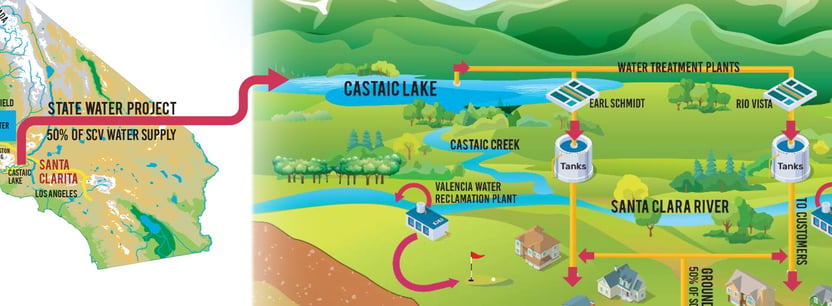 Photo: Copyright SCV Water
Photo: Copyright SCV Water
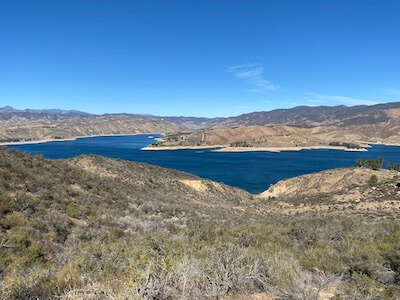
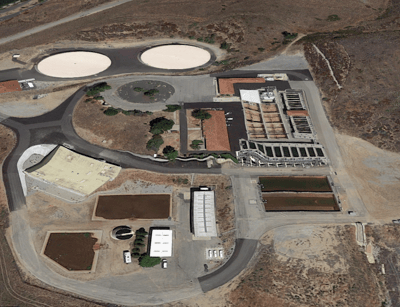
The main treatment processes include an ozone injection system, flash mixing of coagulant and polymer, contact clarifiers, filters, chlorine disinfection, and washwater treatment facilities. The washwater generated by the 10 contact clarifiers and 10 filters is stored in two washwater basins and is pumped to the washwater treatment facilities. Treated washwater is returned to the head of the plant for reprocessing and the collected solids are treated in a gravity sludge thickener and then placed in drying beds. Presently, the treatment plant’s washwater return and sludge collection systems require improvements to not only enhance treatment plant operations and reduce staff maintenance, but also to ensure regulatory compliance.
ESFP washwater is generated from backwashing the contact clarifiers and filters in addition to the filters to waste flow. ESFP generates 2.04 million gallons of daily washwater production, which is approximately 3.6% of total treatment capacity flow. The existing ESFP washwater return system consists of two 400,000-gallon capacity washwater return basins, a chemical injection system, two packaged treatment units (each consisting of a flocculation chamber and an inclined plate separator), a sludge thickener, and two sludge drying beds.
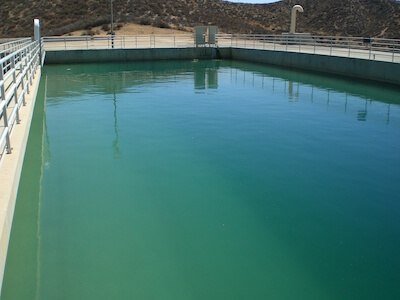
Currently, ESFP is unable to consistently reduce turbidity levels in the return washwater effluent to less than the 2 NTU regulatory requirement promulgated by the California Department of Public Health (CDPH), even though the washwater recycle flow of 3.6% is significantly lower than the 10% allowed by CDPH.
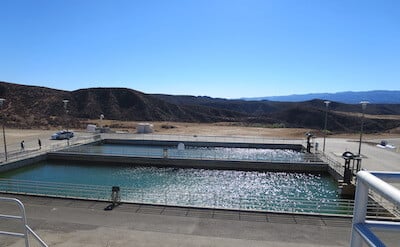
The total washwater return basin storage capacity of 800,000 gallons is inadequate and is also a limitation for maximizing the washwater recycle flow to 10%. To accommodate maximum daily washwater flow, additional basin storage capacity of 1,240,000 gallons is required.
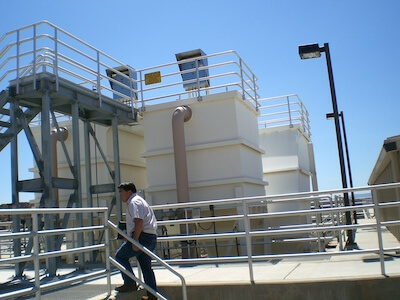
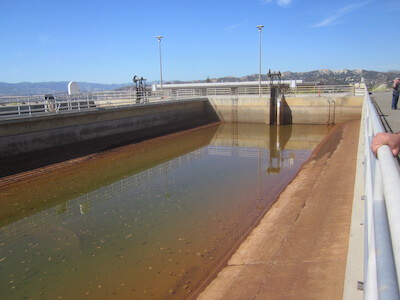
Backwash water from the clarifiers and filters and the filter to waste flows by gravity to the washwater basins. The majority of the sludge in the washwater settles in the bottom of the basins and is then pumped to the gravity thickener. Clarified washwater in the basins is currently pumped to the packaged treatment units for additional solids settling. Unfortunately, the plate separators in the packaged treatment units settle out very little of the solids in the clarified water conveyed to the packaged treatment units because of low relative turbidity of the clarified washwater and because of the high flowrate through each unit. There is insufficient flocculation and settling time to remove the remaining solids and particles to continually measure less than 2 NTU. Sludge from the packaged treatment units is conveyed to the gravity thickener and the treated washwater is returned to the head of the plant for re-processing.
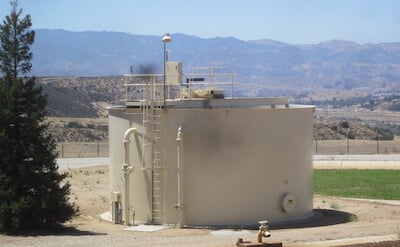
The existing gravity sludge thickener receives sludge from the washwater basins and the packaged treatment units. Typically, the recommended hydraulic loading for a gravity sludge thickener ranges from 0.12 gpm/sf to 0.15 gpm/sf. Currently, the gravity sludge thickener is experiencing loading at 0.3 gpm/sf, twice the recommended loading.
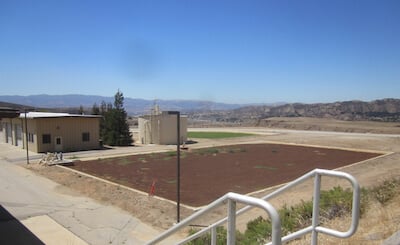
The two existing sludge drying beds provide a drying area of approximately 15,800 sf. Sludge from the gravity thickener is periodically applied to the drying beds in 12-inch layers. Desired loading is typically 15 - 16 lbs/sf of thickened sludge. With only 15,800 sf of area in the two existing drying beds, current sludge loading is 23 lbs/sf.
The ESFP currently is not equipped with an air gap to provide separation between the main water treatment process and the washwater return system to prevent potential cross-contamination as required by the California State Water Resources Control Board’s Division of Drinking Water.
With the present inconsistent turbidity levels, inadequate storage capacity, low washwater recycle flow, and overloading of the gravity sludge thickener and drying beds, upgrades and improvements are required for the ESFP washwater return facilities.

To increase the total storage capacity of the plant washwater return basins to accommodate maximum daily washwater flow, additional storage capacity of 1,240,000 gallons is required. LEE + RO designed two additional basins, each with a storage capacity of 620,000 gallons, to be constructed on the existing ESFP site without additional land acquisition by SCVWA. Each of the new basins was designed to accommodate a future mechanical sludge scraper system. To transfer the sludge from the washwater basins to the gravity thickener, a new sludge pump station was designed for the two new basins and the existing sludge pump station retrofitted. Each sludge pump station includes two (duty/standby) 7.5 hp 200 gpm vertical non-clog pumps along with associated power and controls.

To increase the daily washwater recycle flow rate to the regulatory maximum of 10% of plant design flow, LEE + RO designed a new washwater basin effluent pump station with three new vertical turbine pumps (two duty/one standby), each rated at 2,000 gpm with 60 hp VFD-driven motors and a new motor control center (MCC).
Most of the sludge removal occurs in the washwater return basins and coagulant is injected to help facilitate sludge settling. However, to consistently reduce turbidity levels in the return washwater effluent to less than the 2 NTU regulatory requirement, the packaged treatment units (flocculation chambers and inclined plate separators) were removed from the treatment process and floating decanters were designed for each washwater return basin. The clear supernatant near the surface of each basin is continually skimmed off through the floating decanters and is conveyed to the effluent pump station where it is pumped directly to the head of the plant. Turbidity meters were designed for the decanter discharge piping to monitor basin effluent quality and alarm when turbidity levels exceed 2 NTU.
The existing gravity sludge thickener has dimensions of 30 ft diameter x 14.7 ft sidewall depth, providing a thickening surface area of 707 sf, which yields a solids loading of 0.3 gpm/sf, twice the recommended loading. To reduce the solids loading to the desired 0.12 gpm/sf to 0.15 gpm/sf range, LEE + RO designed a second gravity sludge thickener of the same dimensions, thereby increasing the available thickening surface area from 707 sf to 1414 sf and reducing the solids loading to a reasonable 0.14 gpm/sf. The addition of the second gravity sludge thickener also provides redundancy for when one thickener is out of service for maintenance.

Thickened sludge from the sludge thickener is discharged to the drying beds. To reduce the sludge loading on the drying beds from the current 23 lbs/sf to a more desirable 15 to16 lbs/sf, LEE + RO designed an additional sludge drying bed with a perforated underdrain pipe and a surface area of approximately 6,200 sf. To accommodate the additional drying bed on the existing site and also maintain the vehicle accessway between the drying beds, LEE + RO designed the new drying bed in a trapezoidal configuration.

The existing 30-inch diameter washwater pipe and the 36-inch diameter overflow pipe currently enter the Overflow Weir Structure without any air gaps. To prevent potential cross-contamination by washwater being backed up into the upstream water treatment processes, the existing Overflow Weir Structure design was modified to include an air-gap separation on the 30-inch diameter washwater pipe and 36-inch diameter overflow pipe. The California Division of Drinking Water has defined design criteria for air gap separation, requiring the air-gap separation dimension to be at least double the diameter of the supply pipe, measured from the rim of the receiving vessel to the supply pipe.
To provide the required vertical separation (air gap), a vertical “gooseneck” pipe was designed to elevate the discharge point above the Overflow Weir Structure, and to reduce the vertical separation requirements, the diameters of both the washwater pipe and overflow pipe were reduced to 20-inch. The reduction in pipe diameters reduced the necessary vertical separation distance from 72-inches to only 40-inches. Three 20-inch outlets were designed to accommodate the reduction in diameter. The new air-gap designs provide complete vertical separation protecting the plant main processes from accidental contamination of treated water.
LEE + RO was able to provide solutions for the Santa Clarita Valley Water Agency’s $13.2 million ESFP Washwater Return and Sludge System Improvement project that provides the Agency with the most reliable performance and water quality, maximum washwater storage capacity, ease of operations and low operations and maintenance costs while also ensuring that the facility meets the California regulatory compliance requirements.